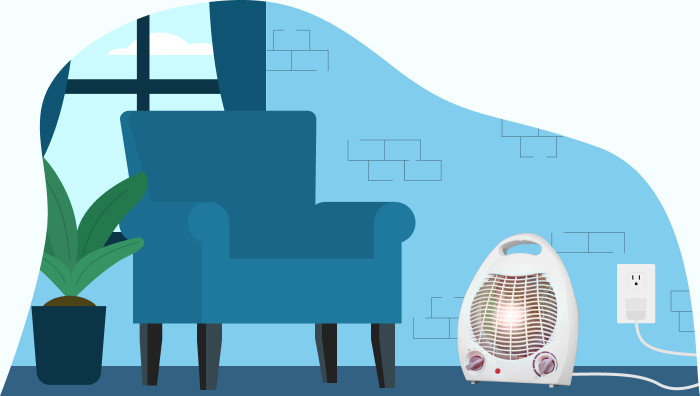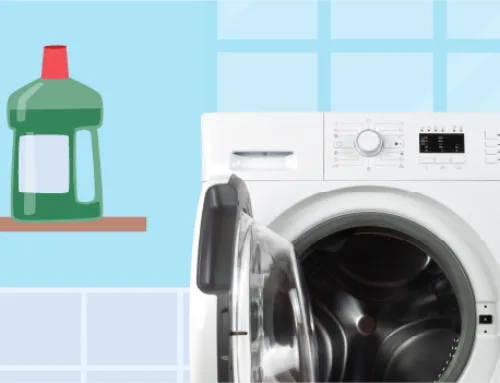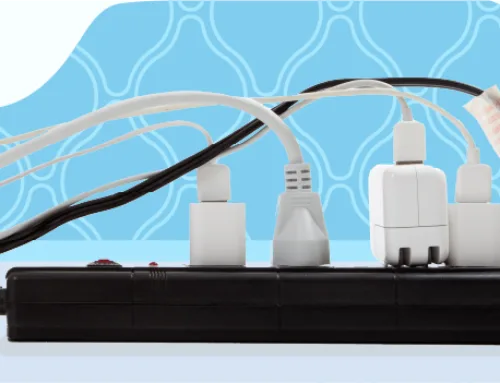Energy Consumption & The Cost of Running a Space Heater
by Tyler Castle
11 min read

Heating bills can be one of the biggest expenses for those of use living in colder climates, especially in the winter. With many American families facing difficulties paying for heating costs, finding a more efficient way to stay warm is a priority.
If you’re looking for ways to lower your heating bill, then you may have thought about investing in a space heater to warm just one room within your home. But are space heaters really more effective than central heating — or are you just exchanging heating and gas bills for higher electricity bills?
This post takes a look at the average cost of space heaters and how they can help save you money — if you use them the right way.
What is a kilowatt hour (kWh)?
Before we can determine how much energy an appliance uses, we have to understand watts and kilowatt hours. Watts are the standard measurement rate of energy consumption, with one kilowatt (kW) equalling 1,000 watts.
A kilowatt hour (kWh) is the metric utility companies use to gauge how much electricity your residence uses over time — specifically, the amount of energy used to generate 1,000 watts of power for one hour. Your monthly electricity bill is based on how much your utility provider charges you per kWh. The rate will vary by your location, provider, and season — with certain times of year (such as summer) incurring higher utility rates due to increased demand from more consumers.
For more information about kilowatts and kwH, visit our other blog post “What is a kilowatt-hour and why does it matter?”
How much electricity does a space heater use?
Most space heaters display their wattage rating, which represents the amount of electricity that the heater uses per hour. You can usually find the wattage listed on the product label, on the product packaging, or in the owner’s manual.
A review of different space heaters on Amazon shows that most home space heaters are rated for 1,500 watts on high and 750 watts for the low setting. Even small, portable space heaters are able to offer up to 1,500 watts performance. Larger space heaters will cover more space within a room, which can warm people faster and enable it to run for shorter periods of time.
Determining how many watts, amps and volts a space heater uses
If you don’t have the listed wattage for your space heater, then the simplest way to determine its wattage is to calculate it via the number of volts and amps.
- Volts (V): Short for voltage, volts measure the difference in electric potential between two points in an electrical circuit. This difference is what causes electric charges to flow from an outlet to your appliance. Voltage tells you how much electrical potential the hair dryer needs to operate. Electrical outlets in North America supply 120 volts, which is sufficient for most appliances.
- Amps (A): Short for amperes, amps measure electrical current. The amperage rating tells you the number of electrons flowing through a circuit, which is how much electrical current the appliance draws.
Multiply the voltage by the amperage to determine how many watts your space heater uses; this will also tell you the rate of energy consumption. On average, most space heaters use 12.5 amps when turned on high and connected to a 120-volt outlet.
Let’s use these figures as an example to determine the kWh energy consumption of a space heater:
- Multiple the voltage by the amperage to get the wattage — 120 volts x 12.5 amps = 1,500 watts.
- Divide the wattage by 1,000 — which for our example is 1,500 / 1,000 = 1.5 kWh.
- Multiply that number by the hours of use, which could range from a few hours to the entire day depending on the times of day when you use the space heater. We’re using 12 hours as the maximum number of hours as the Consumer Product Safety Commission recommends that you do not leave space heaters on while asleep.
- 1.5 kWh x 4 hours = 6 kWh
- 1.5 kWh x 6 hours = 9 kWh
- 1.5 kWh x 8 hour = 12 kWh
- 1.5 kWh x 12 hours = 18 kWh
- To determine your weekly, monthly, and annual energy use, take your estimated daily kWh usage and multiply it by the number of days you run your space heater per week, per month, and per year. For our calculations, let’s assume the space heater is on 6 hours a day and is in use from November to the end of February.
- 9 kWh x 7 days = 63 kWh
- 9 kWh x 30 days = 270 kWh
- 9 kWh x 120 days = 1,080 kWh
How much does it cost to run a space heater?
Once you know your space heater’s kWH average for a span of time, you’ll need to multiply that value by the kWh usage rate charged by your utility company.
For example, at the U.S. average cost of 16.21 cents per KwH, it would cost an average of $44 a month — so around $175 for the winter months — to run a 1,500 watt space heater for six hours a day.
Of course, you don’t have to run your space heater at max capacity, and running it at lower settings can help you reduce electricity costs. Here is a quick reference guide estimating how much it would cost to operate a space heater at both low and high settings for a set period of time.
For these calculations we’ll assume a “full day” of 12 hours for every day of the week from November through February.
Cost to Run an Average Space Heater
(at U.S. Average of 16.21 cents per kWh)
| For 1 day (12 hours) |
For 1 week (7 days) |
For 1 month (30 days) |
For 1 year (120 days) |
|
| Low setting 750 watts |
$1.46 | $10.22 | $43.80 | $175.20 |
| High setting 1,500 watts |
$2.92 | $20.44 | $87.60 | $350.40 |
Cost to Run a Space Heater in Different U.S. States*
And here’s a comparison of electricity costs for different states based on their average kWh charges.
| Michigan 19.06 cents per kWh |
Pennsylvania 18.43 cents per kWh |
Ohio 16.01 cents per kWh |
Illinois 16.01 cents per kWh |
Indiana 15.83 cents per kWh |
|
| Low setting (750 watts) for 1 hour |
$0.142 | $0.138 | $0.12 | $0.118 | $0.113 |
| Low setting for 12 hours over 120 days |
$204.48 | $198.72 | $172.80 | $169.92 | $162.72 |
| High setting (1,500 watts) for 1 hour |
$0.285 | $0.276 | $0.24 | $0.237 | $0.227 |
| High setting for 12 hours over 120 days |
$417.60 | $397.44 | $345.60 | $341.28 | $326.88 |
*costs are based on EIA estimation of average kWH as of October 2023.
Is a space heater more or less expensive than turning the heat on?
During the winter months, is it cheaper to turn up the thermostat or use a space heater? The answer really depends on your local electricity rates compared to your heating rates. Heating bills will vary depending on your local rates of gas or electricity, the temperature you set your thermostat to, and how large your home is.
Estimates for an average monthly heating bill throughout the contiguous U.S. states can range from as low as $30 a month in some southern states to as high as $168 a month in the Midwest. In states with higher estimated monthly average heating bills — such as Illinois ($168), Michigan ($106), or Ohio ($106) — it would be less expensive to run a 1,500 watt space heater for a full 12 hours every day of the week.
Of course, the actual costs will depend on how you’re using your space heater. Smaller spaces, such as single family homes or apartments, may not need to run a space heater on high for the entire day. If you can achieve a comfortable temperature in a room by running on the low setting for a few hours a day, then a space heater will save you even more money.
The larger your home, the more it costs to use central heat and the greater your savings will be if you employ a space heater to warm a single room. However, compared to central heat, space heaters are not as efficient for an entire house. While one space heater is less expensive than central heating, running multiple space heaters could dramatically increase your electricity bill.
For example, running three space heaters on low for 12 hours will cost you around $131.40 a month at the average U.S. kWH rate. Running all three space heaters on high would add up to around $262.80 — much more expensive than even the highest average heating bill.
Is it dangerous to heat a home using a space heater?
While space heaters are convenient and can save you money, they can also be dangerous if used incorrectly. Heating equipment, including space heaters, is a leading cause of fires in U.S. homes, accounting for 13% of all house fires between 2016 and 2020.
If you’re going to purchase or already own a space heater, be sure to check for a label from a recognized testing facility — such as UL Solutions or ETL (Intertek) — that verifies the space heater meets recommended U.S. safety standards.
To keep you and your family safe, be sure to follow these other tips from energy.gov and Consumer Reports when using a space heater:
- Turn off the space heater after using it, when going to bed, or leaving the house. Many space heaters now have an automatic shut-off function for certain or after a set amount of time that helps reduce your risk.
- Place the heater on a hard, level surface away from foot traffic. Don’t place it on carpet or on tables. Give it the right amount of space and be sure to keep it safely away from children and pets.
- Plug the space heater directly into a wall outlet if possible. If you do need to use an extension cord, prioritize a heavy-duty cord rated for drawing 10 to 15 amps of power.
- Be sure to always follow general electrical safety practices when using any electrical appliances or outlets.
FAQs
Do portable heaters use a lot of electricity?
At an average of 1,500 watts for the high setting, space heaters use a high amount of electricity compared to other appliances. Even full-sized refrigerators only average around 800 watts. While some smaller appliances such as hair dryers can draw even larger quantities of electricity, they’re used for a much shorter amount of time.
Are all electric space heaters 1,500 watts?
On average, most commercial space heaters will have a maximum high setting of 1,500 watts and a lower setting of 750 watts.
How big of a room can a 1,500 watt space heater heat?
Assuming 8-foot ceilings and good insulation, it takes roughly 10 watts of heating power for every square foot of floor area in a room. So, the average 1,500-watt heater should be able to heat a 150 square foot room. However, that equation changes a bit due to other variables, such as higher ceilings, lack of insulation, number of windows, and average outside temperature.
Do portable heaters run up your electric bill?
A single portable heater won’t use an excessive amount of electricity provided that it’s not running 24/7. However, if you run multiple space heaters at the same time in different rooms, you could spend more on electricity than you’re saving on heating.
Does a portable heater save money?
It can be cheaper to use a portable heater, rather than central heating, to warm up a single room.
How can I save electricity with my space heater?
Smart and careful usage of a portable space heater will help save you money, but excessive use can run up your electricity bill. Here’s what you need to know to save on electricity when using a space heater.
- Determine when to use your central heating vs. an electric space heater. If everyone is gathered together in one room, then using a single space heater makes sense rather than heating up the entire house. However, if you have people in multiple rooms, it’s more efficient to heat the house rather than run many different space heaters at the same time.
- Use a timer or settings to automatically set your space heater. The longer a space heater runs, the more electricity it consumes. Modern space heaters will have automatic settings to turn off after a set amount of time or when the area reaches a specified temperature. Using these automatic presets can ensure you’re not wasting electricity.
- Cover up while indoors during the winter months. The best way to stay warm during the winter months is to dress warm. Wear extra layers of clothing, socks, and slippers to keep warm as you move through the house. That way, you don’t need to set your space heater or your central heating too high.
- Take the right steps to better conserve heat in your home. Besides dressing warmly, there are other ways to winterize your house to conserve heat. Purchasing smart thermostats, buying heavy curtains, covering air leaks, and updating your insulation are the most efficient ways to save money on heating.
- Select an energy plan that fits with your lifestyle. If you want more control over your energy bill and don’t want to worry about spikes in your kWh charges, see if your retail energy provider offers Unlimited Energy or Fixed-Rate plans.Fixed-rate plans guarantee a cost that does not change for a specified period of time, while unlimited energy plans allow you to pay the same amount every month without worrying about fluctuating energy costs.*You can even choose Earth-Friendly Energy plans if you want to power appliances with renewable electricity plans or heat your home with carbon-neutral gas plans.
* Restrictions apply. Enrollment based upon program eligibility. Customers using more than 125% of normal monthly usage as determined by Santanna may be required to switch plans.
Tyler is an experienced energy professional, having worked for Santanna Energy Services, for the past four years. He is passionate about renewable energy and believes that diversifying the energy grid is the key to a sustainable future. Tyler is dedicated to supplying consumers with the best possible energy solutions and works diligently to make sure that Santanna can deliver the highest quality service.






